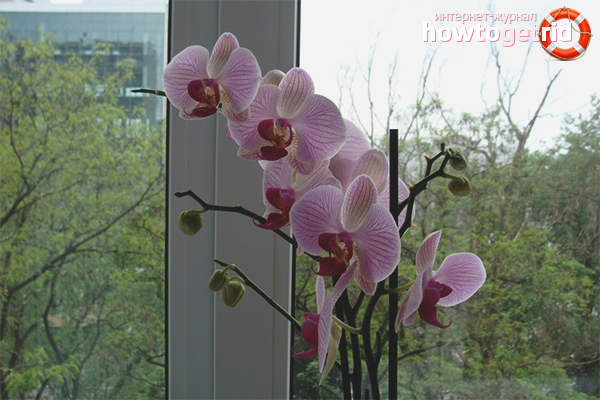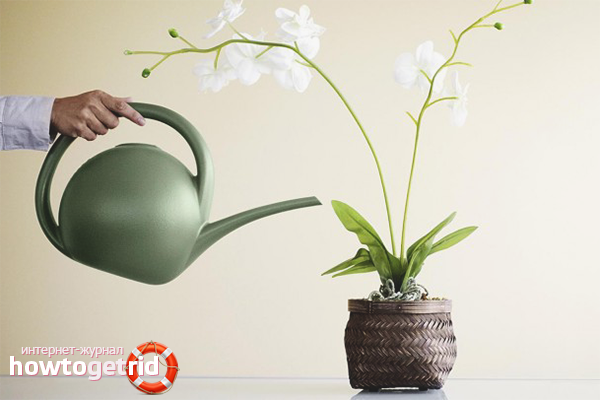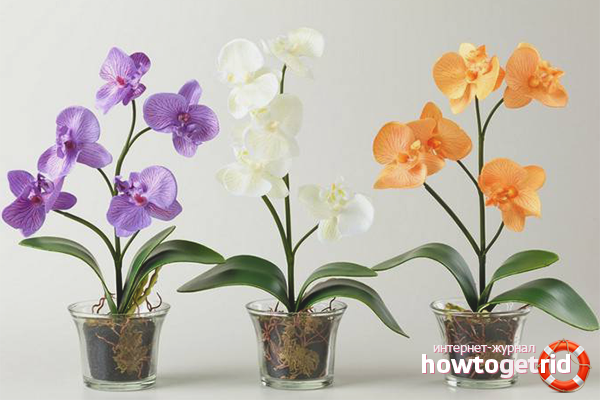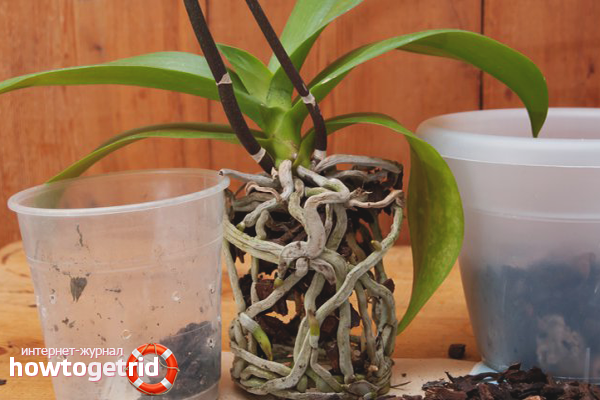The content of the article
Orchid - amazingly beautiful home plant with an exotic flower. However, the complexity of care repels many flower lovers from its breeding. The experience of experienced flower growers and their observation in the process of growing orchids will help to cope with the most capricious variety and eventually get a healthy flower. It is said that the orchid growing in the house brings love to its inhabitants, and in ancient times it was considered a symbol of rebirth. Many will consider carefully grown orchid a wonderful gift.
What conditions need to provide orchids
Today there are more than thirty thousand species of orchids, but not all of them are suitable for growing at home. For the first orchid in the house, it is better to choose a famous variety from a flower shop: phalaenopsis,shoes, dendrobium. Regardless of the variety, it is necessary to provide the plant with certain conditions, which include:
- adaptation after purchase;
- lighting;
- watering and fertilizer;
- soil and pots for transplanting;
- temperature and humidity.
For some varieties, the intensity of irrigation or the mode of illumination of the room may differ, therefore it is recommended to find out all the nuances of care before buying a flower. This will help avoid disappointment in growing orchids.
Adaptation period
It is better to hold the indoor plants in the store for a while in quarantine. This primarily concerns the capricious and demanding orchids, which are very sensitive to moving, changing conditions and conditions of detention.
The quarantine phase for an orchid lasts about two weeks, but you need to judge, first of all, by the state of the flower. It may take a little more or less time. During this period, the plant is better to put separately from other indoor plants, you can even in a not very lighted place.
Watering is also better to postpone. Do not be afraid that the plant will die from drought, because orchids tolerate arid soil much better than excessively wet soil. When buying a flower in the store in the appendage to him often go various fertilizers.For the period of quarantine, no additional fertilizing is needed, much less protection against pests that the flower may not have.
Exit from quarantine should be made gradually. First you need to add a little light, then you can connect the watering. Various fertilizers are introduced last, as soon as possible after purchase, in order for the plant to get used to the new habitat.
Lighting in the growth zone of orchids
To whimsical plant bloomed, he needs to find a bright place. The most successful option would be to place an orchid next to the window sill. A daily dose of solar energy will help the flower to develop properly. Only with lighting, you also need to be careful.
Direct sunlight is detrimental to these plants. Excessive light can cause orchid leaves to burn. Therefore, they make shading for them. You can use ordinary blinds, which are quite easy to adjust the desired level of illumination, focusing on the state of the flower. If the leaves are lowered and become lighter, then you need to add a little light and slightly open the panels.
But many just put in the glass, in the zone which will grow orchids, frosted glass. It provides uniform diffused sunlight, which cannot be achieved with the help of blinds. This option is acceptable for sunny regions, where even in winter the sun shines quite brightly. Otherwise, it is better to do with shading lining of a matte film or a translucent plastic screen.
Insufficient lighting can also lead to negative consequences for the flower. In principle, in winter, the orchid is at rest, its flower buds are laid and new shoots mature. In this case, enough natural lighting. But if the light is sorely lacking, then the leaves will start to turn yellow. Then you need to think about the organization of artificial lighting. For these purposes it is better to use fluorescent lamps.
Temperature conditions
For regular orchid flowering, it is important to maintain the correct temperature in the room. Then the flower will delight the good condition of its leaves and beautiful flowers. Three types of orchids can be distinguished according to the temperature of keeping: heat-loving, preferring the average temperature and loving coolness.And in the same room it is not recommended to contain flowers with different recommended content temperatures.
Phalaenopsis and dendrobium are among the thermophilic varieties. In summer, the temperature can reach 32 ° С above zero, but it can be maintained at 15-18 ° С, the main thing is that the daily difference does not exceed three degrees. That is, the plant will feel comfortable both at 15 ° and 32 ° if these thermometer indicators are stable throughout the day and night. The cold season is a kind of "hibernation" for orchids, so the temperature should not exceed 18 ° C.
Medium temperature plants like cooler air compared to heat-loving varieties. These include monoglossums and miltonia. In summer, the temperature should not exceed 22 ° C, and in winter it can be from 12 ° C to 15 ° C. Cold-loving orchids include lelias, Australian dendrobiums and pafiopedilyulyums. In the wild, they are found in a subtropical climate, highlands. In summer, they need to choose a temperature within 20 ° C, and in winter, around 12 ° C.
Most of the plants purchased in flower shops belong to heat-loving and medium-temperature plants.That is, the temperature within 22 ° C in the summer and 15 ° C in the winter will be quite comfortable for them. At the same time it is necessary to monitor the indicators of humidity. If different heaters are used to maintain the correct temperature in the room with flowers, periodically spray water or leave open containers with water.
To maintain the required indicators of air humidity (60-80%), you can use special pallets. They contain small drainage stones, such as gravel. Water is poured at the bottom, and you can put a grate on top. The bottom of the pot with a flower should not be in contact with water. In hot weather, orchids should be slightly sprayed with clean water from a spray bottle. You also need to periodically air the room with flowers, while avoiding strong drafts.
Correct watering
The mode of watering any orchids is very important for their full growth. As with temperature, each class has its own preferences in soil moisture. But It is worth noting that all types of these plants do not like stagnant water, as their roots begin to rot. Therefore, it is better not to be zealous in their watering even in seemingly very hot weather.
Such orchids as phalaenopsis, cymbidium, odontoglossum are more hygrophilous.They should be slightly wet soil. But dendrobium and cattley prefer that the potted earth dries completely between waterings.
Also important is the process of irrigation and the choice of water. Ideally, for irrigation of indoor plants in winter they use melt water, and in summer they defend rainwater. The same option is preferable for orchids. But if it has not been raining for a long time and the reserves of such water have been exhausted, it is possible to use ordinary water from wells, also previously settled. Tap water is often too hard for watering flowers and requires additional softening and cleaning.
More intensive watering, in comparison with the usual mode, is required for flowers in the phase of active growth and in the flowering period. But after flowering and in winter, moisture is practically not needed by orchids, because the plants have a rest phase.
The best way to water an orchid can be considered the one where the plant itself takes as much moisture as it needs. That is, put a pot with a flower in a container with water for 10-15 minutes. Thus, there is a natural absorption of moisture. But you can also plentifully pour the plant under a warm shower until the water drips from the drainage holes.After any of the methods of watering the orchid pot is placed on the grate so that excess moisture can drain. So you can prevent the stagnation of water and rotting of the roots of a sensitive flower.
Selection of pot and soil
For epiphytic orchid varieties, the ground, as a rule, does not contain the usual ground from the garden. For its growth, a substrate is collected from tree bark, coal, moss, fibers, coarse sand and granulated clay. This mixture is able to pass a sufficient amount of air to the roots, and not to retain moisture around them. For ground varieties of orchids, garden soil and crushed dry leaves are already added to the substrate.
As a pot you can use baskets, wicker pots, wire mesh containers. Holes in lattice pots should be small so that the extract does not wake up. For ground varieties, you can use ordinary plastic pots (preferably transparent) with a lot of drainage holes. And you can hide not too attractive plastic with decorative baskets. If the purchased capacity has only a couple of holes, then the rest can be done independently.
For a grower who is only acquainted with the cultivation of orchids, it is better to buy a special substrate for his species. For example, if the package says “For phalaenopsis”, you can safely use it for all epiphytic varieties. A mixture for ground varieties can be prepared from purchased soil for phalaenopsis by adding garden soil and crushed dry moss to it.
Independently produce soil for growing orchids is quite problematic. Not always the necessary components. And even if a little money is saved, then it will take a lot of time to search for ingredients, grinding and mixing them in the right proportions. A well-known brand extract purchased from a specialized store or nursery is quite suitable for growing home-made orchids.
Need fertilizer
Many growers believe that the constant and excessive use of fertilizers significantly reduces the immunity of plants. As a result, indoor flowers become too susceptible to various changes in climate, are subject to diseases. This is especially true for naughty orchids.
The use of fertilizers is recommended only during the period of active flower growth.Feed the plants with better known compounds purchased in nurseries. In no case can not use fertilizers that are designed for other colors. Orchids can not stand it and die.
It is better to give up top dressing at all during the rest period (in winter, after flowering). This can disrupt the phase of active growth and rest in the flower. Mixture must be diluted according to the instructions on the package. Feed should not be administered more than once every two weeks. Orchids can die from the salt concentration on the roots. Therefore, it is better to alternate weekly irrigation with mineral fertilizers and ordinary water.
Ideally, a healthy orchid does not need any additional feedings and it can take all the substances necessary for its growth from the extract. But this is on condition that the soil has the composition necessary for the flower and the plants are watered correctly, the temperature is maintained and full lighting is established. You also need to know that the extract should be changed once every two years to contain a sufficient amount of minerals.
Flower transplant
The need for transplantation is indicated not by the bare root system of an orchid, but by its leafy part that has grown beyond the edge of the pot. Then the flower is really cramped in a pot and needs to be transplanted. It is not necessary to start the process during the rest period of the orchid, as in the new soil the plant can not be taken, because all its life processes will be suspended.
The best time for a transplant can be considered the beginning of a new growth period. That is, the plant has already rested after flowering and is ready to re-delight the appearance of its charming flower. So it is possible with a guarantee to assert that the plant will actively and calmly transfer the transplant.
A new pot should be one or two sizes larger than the previous one. Too large amount of capacity for planting can lead to the fact that moisture will be retained in an excessive amount of the extract. The flower must be carefully removed from the old pot and as much as possible remove the remnants of soil from the root system. Rotted and dried roots should be carefully cut, in a new place they have nothing.
At the bottom of the new pot, you must first pour a little new substrate, and only then place an orchid there.Above you need to fill in a sufficient amount of new soil and slightly press it, but not to tamp. The extract should fill well all the free space between the roots of the flower.
The growth point of an orchid should not be covered with earth after transplanting into a new pot and located just below its sides. The soil should be slightly moistened, but not filled with water. After transplantation, it is better for the plant to organize a small quarantine for several days: put it in a dark place and temporarily not water it.
Before you start growing your own orchid at home, you should carefully study the issue of its maintenance and prepare everything you need in advance. Then you can hope that the flower will grow healthy and will regularly delight in its flowering.
Video: Orchid Care Secrets















To send